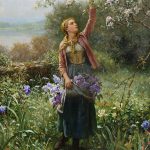Daniel Garber, born on April 11, 1880, in North Manchester, Indiana, was an American landscape painter associated with the Pennsylvania Impressionist movement. Renowned for his luminous and vibrant depictions of the American countryside, Garber’s works earned him recognition as a master of American Impressionism in the early to mid-20th century.
Garber’s early interest in art led him to pursue studies at the Art Academy of Cincinnati before continuing his education at the Pennsylvania Academy of the Fine Arts (PAFA) in Philadelphia. Under the guidance of artists such as Thomas Anshutz and William Merritt Chase, he honed his skills and developed a deep appreciation for the plein-air painting approach.
In 1905, Garber traveled to Europe, where he immersed himself in studying the works of the Old Masters and contemporary European artists. This experience broadened his artistic perspective and provided inspiration for his future endeavors.
Upon returning to the United States, Garber joined the faculty at PAFA, where he became a beloved teacher known for his emphasis on traditional techniques and academic principles. His dedication to teaching left an indelible mark on generations of aspiring artists.
Garber’s artistic style evolved over the years, transitioning from a more academic approach to embracing the tenets of Impressionism. His mature works, such as “Tanis” (1915) and “The Orchard” (1916), reflected his adept use of color, light, and brushwork to capture the atmospheric effects of nature.
One of Garber’s most celebrated paintings is “The Artist in His Garden” (1914), a self-portrait that showcases both his proficiency in capturing the human form and his deep connection to nature. The painting stands as a testament to Garber’s ability to integrate traditional portraiture with the atmospheric qualities of Impressionism.
Garber was closely associated with the New Hope art colony in Pennsylvania, a gathering of artists drawn to the picturesque landscapes along the Delaware River. The region’s scenic beauty became a primary source of inspiration for Garber, who often painted en plein air, capturing the changing seasons and the play of light on the landscape.
In addition to his landscapes, Garber painted numerous portraits and figurative works. His commitment to both portraiture and landscape painting showcased his versatility and mastery of different genres within the realm of American Impressionism.
Garber received numerous awards and accolades throughout his career, including the Temple Gold Medal from PAFA. His works were exhibited widely, and he became a prominent figure in American art circles.
Daniel Garber continued to paint prolifically until his death on July 5, 1958, in Bucks County, Pennsylvania. His legacy endures through his contributions to American Impressionism, his impact as an influential teacher, and the timeless beauty captured in his canvases that transport viewers to the serene landscapes he so passionately depicted.






